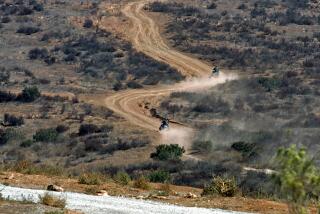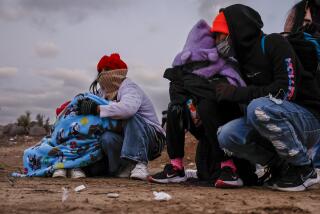Border Patrol sees little reform on agents’ use of force
Nearly a year after the Obama administration vowed to crack down on Border Patrol agents who use excessive force, no shooting cases have been resolved, no agents have been disciplined, a review panel has yet to issue recommendations, and the top two jobs in internal affairs are vacant.
The response suggests the difficulties of reforming the nation’s largest federal law enforcement force despite complaints in Congress and from advocacy groups that Border Patrol agents have shot and killed two dozen people on the Southwest border in the last five years but have faced no criminal prosecutions or disciplinary actions.
Administration officials insist they are moving as quickly as possible in a thicket of federal bureaucracy, union rules and an internal culture that closes ranks around its paramilitary force.
R. Gil Kerlikowske, commissioner of Customs and Border Protection, the parent agency for the Border Patrol, said in an interview that he was reviewing 14 shooting cases for possible violations of agency rules on use of force.
“I’m not sure we will reach a level of satisfaction with the public on every one of those cases,” Kerlikowske said, pointing to a thick file of cases on his desk. “But we will be much more thorough, much more accountable and we will be much more transparent … going forward.”
The lethal shootings, and the alleged lack of accountability, were so problematic when Kerlikowske took over last March that he ordered limits on when Border Patrol agents were permitted to fire their weapons.
The new rules required agents to seek cover or move back, when possible, from people throwing rocks. Agents were urged to seek alternatives to opening fire, following guidelines used by most domestic police departments.
Shootings continued, however. Last May, a border agent shot and killed a U.S. citizen who was allegedly smuggling marijuana near Green Valley, Ariz. In October, another agent shot and killed a Mexican man after an altercation southwest of Tucson. Four more people were shot and wounded in other incidents.
Kerlikowske also shook up the agency’s office of internal affairs. In June, he removed its longtime director and brought in an outsider, Mark Morgan, a supervisor in the FBI’s Inspection Division, to revamp investigations of abuse and corruption.
But Morgan returned to the FBI in December and the top job at internal affairs has not been filled. The No. 2 official, Paul Hamrick, left in July, and that job also remains open.
In a telephone interview, Morgan said he left because he wanted to finish his career at the FBI before he retires. He is now a senior manager at the FBI training facility in Quantico, Va.
Kerlikowske said more than 60 candidates had applied to run internal affairs, which has 580 employees and a budget this year of $140 million. He said he hoped to fill the top two jobs “in the next month.” For now, temporary managers run the office.
In September, Kerlikowske created a panel to review allegations of excessive force. But the panel did not convene until December and has yet to make public any recommendations for changes to training, rules or discipline.
Advocates for families who have lodged abuse complaints with the Border Patrol say the agency has not become more responsive to their concerns and has not moved to resolve long-standing cases over the last year.
“We are concerned that there isn’t a sense of urgency at revisiting the cases that weren’t properly investigated,” Chris Rickerd, a border security expert for the American Civil Liberties Union in Washington, said in a telephone interview.
The internal affairs unit has faced problems since the Homeland Security Department was cobbled together from 22 federal departments and agencies after the Sept. 11, 2001, attacks.
Customs and Border Protection, which has more than 60,000 agents and officers, saw most of its abuse investigations outsourced to a sister agency, Immigration and Customs Enforcement, and to the Homeland Security’s Office of Inspector General. Internal affairs instead conducted lie detector tests, did performance reviews, and dealt with questions from outside agencies.
Most of that work was shifted elsewhere last fall. In September, internal affairs was given expanded authority to investigate charges of excessive force and other potential abuses by Border Patrol agents and customs officers.
Not everyone approved. Shawn Moran, vice president of the union that represents most Border Patrol agents, decried the new rules and stepped-up investigations as unnecessary and ineffective.
“I don’t think [the changes] will have a huge effect,” Moran said in a phone interview from San Diego. Current investigations into use of force, he added, “are very thorough.”
Allegations that the Border Patrol condoned excessive force gained credence in 2012 when the Police Executive Research Forum, an independent group of law enforcement experts, was granted access to the agency’s internal files and reviewed 67 shooting cases.
The group’s report, completed in 2013, criticized Customs and Border Protection for a “lack of diligence” in investigating deadly force incidents. The study said agents had deliberately stepped in the path of cars to justify shooting at the drivers, and had fired in frustration at people throwing rocks from the Mexican side of the border.
The agency later adopted several of the report’s recommendations, including forbidding agents to shoot at unarmed drivers and revising training to increase use of nonlethal weapons such as Tasers.
Morgan, the FBI supervisor, reviewed the 67 shooting cases with other investigators last year. They concluded that 14 needed further scrutiny by internal affairs. Last month, the unit referred the 14 cases to Kerlikowske, chief of Customs and Border Protection.
In the interview, Kerlikowske said some of the shootings may have violated department training or rules, or were insufficiently investigated. He said he was reviewing the 14 cases, and would recommend disciplinary action if he found excessive force was used.
Border Patrol agents and officers have shot and killed a total of 24 people since 2010, according to the ACLU, which tracks the cases. At least 10 incidents involved people allegedly throwing rocks. Eight were across the border when they were killed.
The Border Patrol also suffered casualties during that period.
In December 2010, Brian A. Terry was shot and killed while tracking a group of armed men near Rio Rico, Ariz. In October 2012, another agent, Nicholas J. Ivie, opened fire on two fellow agents, apparently thinking they were armed smugglers, and was killed when they returned fire. Six other agents died in vehicle accidents.
Courts are intervening in some cases.
On Feb. 10, U.S. District Judge James A. Soto in Tucson ordered the government to pay $500,000 to a Mexican man who was shot and wounded by a Border Patrol agent. The agent, Abel Canales, was on horseback and said he fired after the man, Jesus Castro-Romo, drew his hand back to throw a rock.
Prosecutors did not charge Canales with a crime. But in the civil suit, Soto found the agent’s decision to open fire “was not based on a reasonable fear of his immediate safety,” according to court documents.
Bill Risner, a Tucson lawyer who represented Castro-Romo, said the case fit a pattern of agents overstating the threat from rock throwers.
“We have seen situations where they claim someone is throwing a rock and therefore they get to shoot them,” Risner said. “That’s been thought of as a complete defense, or something. It’s very good to see that this judge could view these allegations realistically.”
Assistant U.S. Atty. Mark Pestal said his office would review Soto’s ruling before deciding whether to appeal.
Twitter: @ByBrianBennett
Times staff writer Joseph Tanfani in Washington contributed to this report.
More to Read
Start your day right
Sign up for Essential California for news, features and recommendations from the L.A. Times and beyond in your inbox six days a week.
You may occasionally receive promotional content from the Los Angeles Times.







